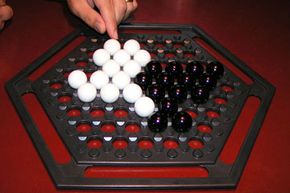The two-player board game of Abalone is an odd synthesis of brain and brawn, in that it’s probably the only strategy game loosely inspired by sumo wrestling. Invented in the late 1980s by two French artists, Michael Latet and Laurent Levi, Abalone was introduced to hip denizens of London’s café society in the 1990s, and it migrated across the Atlantic to become a favorite of brainy American college students, as well. One British newspaper writer described the game as a "fiendishly simple" cross between checkers and Go, the Japanese strategy game [source: Hughes-Morgan]. According to the game’s manufacturer, more than 4 million copies of Abalone have been sold in 30 countries [source: Foxmind.com].
Part of Abalone's addictive appeal is that it can be learned in minutes and has a clear, easy-to-grasp goal -- pushing six of the opponent's 14 marbles off the board by outnumbering them [source: Campos and Langlois]. But as with many of the great strategy games, Abalone's simple concept serves as a tabula rasa, or blank slate, upon which players with sufficient smarts can craft complex, ingenious strategies for victory. Indeed, Abalone is so intellectually challenging that it won an award in 1990 from American Mensa, the society whose members have genius-level intelligence [source: American Mensa]. Portuguese computer scientists found the game so intriguing that they designed Abalearn, an artificial-intelligence program that teaches itself how to play. But it's a measure of Abalone's complexity that the program is only able to compete with intermediate-level human players [source: Campos and Langlois].
Advertisement
In fact, Abalone is so respected among smart people that, along with stalwarts like chess and backgammon, it's included in the annual Mind Sports Olympiad (MSO), a competition that pits top strategy-game players from across the globe. MSO's Web site calls Abalone "a modern classic" and notes that for a mental contest, it also has an alluring sensual quality -- as players push the marbles against one another and make a rhythmic clicking [source: Boardability.com].
In this article, we'll give you some strategy tips on how to win at this seemingly simple, yet beguilingly complicated, strategy game. But first, here are the basic rules for playing Abalone.
